|
THE
AUTOMOBILE: DESIGN AND CONCEPT
By
Omer Brans
How
can we predict solutions and plans for cars of the future to ensure
commercial success and the durability of the enterprise? This is the
objective of numerous car manufacturers, each of which has his own
methods, often drawn from the history of car manufacturing itself.
To
reach this objective, it seems inevitable that reference will be
made to certain analytical tools from which many lessons can be
drawn. It is out of the
question to review such questions here as this would require a
literature of encyclopedic proportions, but we have chosen a few
points that we consider vital, and that we have essentially
integrated into the know-how of our research department.
First and foremost, we must research what has already been
achieved by other manufacturers or creators in order to gain insight
into what should be done, but more importantly, what should not.
One cannot broach this subject without having first developed
the statistical tools of analysis to illustrate the coherence of
each creation. These
tools, which one could call "quality criteria" facilitate a
comparison of vehicles and the uncovering of a cause-effect link
between commercial success (or failure) and these quality criteria.
The most basic of these tools take the following form: cost
per km per passenger, frontal area per passenger, total wet area Cx/passenger,
total wet area Kg/cc, Kg/cc/passenger cell volume, etc.
What are the most judicious tools for this purpose? We leave
this to the imagination, the range of choice being almost limitless.
There is always a reason (though often hidden) for the
failure or the success of a vehicle; the key is to find the right
tools to update the predominating aspects in this event.
It seems preferable to foresee problems, rather than
encounter them later.
Many
other points should be taken into account, and the evolution of
technique is so rapid in certain domains that often no scientific
means exist to provide foresight into how a project will be received.
In fact, we gain knowledge through experience; unless science
is innate, even those who are most competent will need a course in
concept-manufacturing-marketing to draw conclusions from this
experience and develop expertise concerning this type of project.
Nonetheless, and this is not an exception, intuition, when
mastered, often facilitates a projection into a future reality and
is certainly the most powerful and dynamic tool in the world.
All creators use it, with varying degrees of satisfaction and
varying degrees of consciousness. Just as one develops the functions of a software program, it
is necessary to know how to cultivate this ability in order to
optimize creative capacity. This
is why, very often, one man is at the origin of a gigantic
production and, without him, the creation would have remained at a
standstill for years, perhaps never even coming into being.
The examples are numerous.
For this reason, the size of a research department is never
proportionate to its competence, even though there is a great risk
of associating these two parameters. Intuition is probably the most difficult element to identify,
subtle as it is, but nothing would be worse than to reject this type
of imagination and to stick stubbornly to an overly rigid mental
scheme, incompatible with creativity -- intuition being infinitely
superior to reflection, but the practice of both being ideal.
We are convinced that it is of prime importance, before
embarking upon any new project, to take interest in the personnel --
to allow them to express their creative ideas by optimizing training
methods and knowledge, and by careful management of hierarchy and
responsibilities. Creativity
cannot be realized if there is neither the scientific or technical
basis, nor if it is limited to the performance of sterile tasks.
Each of us needs to take responsibility for identifying and
evaluating creativity, and, in our view, this is where most of the
work lies. One too
often forgets that the business is nothing and the personnel, the
men and women who produce the ideas, are everything.
On
the other hand, the equipment, in particular the computer science at
our disposal today, the strength of which has caused a veritable
transformation of our research departments, is a double-edged sword.
In fact, the computer is so full of charm and potential that
the engineer can find himself, in a way, hypnotized by the machine,
unbeknownst to himself. He can make the machine an end in itself,
whereas it should remain only a means to an end. The engineer is
absorbed into his screen without realizing it; he can no longer use
his imagination, he simply plays with the functions of the software.
We believe it is preferable to succeed in a project planned
in the corner of a restaurant than to fail on Catia. To our
knowledge, the latter has unfortunately already happened with an
aeronautical program. The success of a project depends also on
giving importance to "form" and "environment": it depends on
bringing together several elements (machines, human beings, premises,
etc.) and combining them wisely.
This osmosis is not spontaneous, and it is up to the
company's director to involve himself deeply in the task, without
which serious setbacks can occur (as we have seen in the case of
some manufacturers), resulting in disaster; both on commercial and
technical levels, like Mercedes, for example (Smart, A5 and the Mans
24H).
To
succeed in a project means for some manufacturers to follow the
general movement, either in imitating competition or improving on it,
but the most advanced will have understood that above all it is
essential to precede this movement, to stay lengths ahead. This necessitates not only accepting a large risk factor, but
also applying progressive and rational methodology supported by a
development of the users' expectations; a kind of barometer which
must facilitate the evaluation of, not the trend changes, but the
real changes which occur and of which society is often also the
reflection. Here we are
no longer talking about trends. These terms are already over-stepped because that which
creates a trend in turn goes out of fashion and represents an aspect
too ephemeral and of little interest.
To slightly change the shape of a bumper, add a piece to the
steering wheel, to make minimal aesthetic modifications for no
rational reason (no major improvement in a technical aspect of the
vehicle), at times making the general line even more cumbersome, as
did some Japanese manufacturers, all simply to give the impression
of a new model -- a result purely of market considerations: this
takes the buyers for wallet-owners with low IQs.
This type of production is absolutely incompatible with any
kind of realistic vision of the future.
THAT
WHICH IS OVERLY EXCESSIVE TIRES QUICKLY
To
commit to a style -- for example, forms which concentrate solely on
broken lines or, oppositely, solely round lines, like bio-design --
is to accept from the moment of creation the death of the project;
this representation is too manichean to correspond to the lasting
vision that a human being has of the vehicle, which must evolve in a
world of variables and delicate nuances. That which is overly
excessive tires quickly. It is all a question of striking a balance,
a refined cuisine which must not disgust the buyer.
The great potential of the technology used and the
advancement of this futuristic vehicle must succeed in inciting
surprise and admiration, and avoid provoking disinterest.
Porsche perfectly achieves this point, and the starting
potential of its cars is extraordinary.
This is largely due to technical coherence, mechanics and
aerodynamics advanced and optimized almost to the maximum from the
beginning. Other
manufacturers prefer to relive the evolution of the automobile,
going through every phase imaginable, even if this has no rational
basis, but simply follows the fashion.
This root is endless as the combinations are endless.
Only the physics, the aerodynamics, the resistance of the
materials, the ergonomics, among other factors, have logical rules,
and it is in understanding and respecting these that we approach a
future reality: it is with these rules that the vehicle must comply,
and not to the subjective fantasies of a project director who gives
in to the whims of fashion. The
most difficult task is to synthesize all these factors into a
homogenous creation in which each element is in harmony with the
next. The ultimate goal is to make these elements multifunctional,
to generate a diffusion of systems, synonymous with security and
efficiency. The
approach to this type of design must not be the traditional, but
should be realized around basic elements precisely defined from the
outset. If we take the
example of the aeroplane: it is preferable to manufacture an
aeroplane around an engine and passengers, and not the contrary,
meaning to try to put an engine and passengers in an airframe
constructed using arbitrary dimensions.
The parallel between this methodology and that used in cars
illustrates an obvious opposition. No other approach, in our view, allows one to envisage the
long-lasting success of a project for the future.
VEHICLE
PHILOSOPHY MUST MOVE FORWARD
Apart
from the purely technical aspect, the philosophy surrounding the
vehicle must also advance. From a simple cart with an engine, we
have arrived at a means of transport both reliable and secure.
But the evolution does not stop there, because, in fact, it
never stops, and it is in the mentalities and in the new needs of
men and women that we will find the reasons behind the success of
the new vehicle. It is
certainly not in the research department where we will find the
initial spark of this answer. In
fact the advisers are not the buyers and it is the user and not the
creator who will buy this vehicle in accordance with his needs of
the moment or of the future, of which he is often not yet aware.
His needs are strongly linked to social, economic and
political factors often difficult to bring to light.
But the trend these recent years has been towards a reduction
in working hours, towards a democratization of leisure pursuits, and,
on one hand, a rupture in the cell that was the family, and, on the
other, a reinforcement of the latter.
More pronounced extremes in a way, just as in the working
world. The advent of
space and monospace is the logical consequence of this state of
affairs where the largest habitable volumes liberate the vehicle
from certain constraints and render it more fit to live in.
One tries to enjoy life and the family in an environment
which is becoming more and more hostile, and one works to live
rather than lives to work. The
automobile is becoming more and more a space for living and, with
the new communication technology, will inevitably become a workspace.
A means of transport, a space for living, and soon a mobile
office, a space for games and culture, this is what we look forward
to because we have a real need for it. All these conditions are
obviously insufficient and numerous other factors enter into the
picture (drivability, dimensions, modularity).
In fact, more and more conscious of the value of things, the
client pleases himself rationally by thinking of his family and,
even if he wishes to be valued by his vehicle, he will always make a
choice with corresponds to his reality and his mental scheme, his
mindset.
CARS
ARE BOUGHT PRIMARILY ON APPEARANCE
The
buyer must be able to visualize himself in the vehicle which he has
chosen and which suits him. But
the only aspect which the buyer, who is not a technician (as is most
commonly the case) can understand easily is the vehicle's
appearance. He won't need any special training to say whether he
likes it or does not like it, and if, however, this simplistic
vision gives him access to a mild sort of comprehension of the
vehicle, it is nonetheless an important comprehension which will
satisfy him a good deal. The
less knowledgeable one is about mechanics, the more important the
form (its aesthetic value) and the less important the content (the
mechanics). A car is
often bought, therefore, based on its appearance, which must
correspond to the image the buyer has of himself, in character as
much as in physical appearance.
It is for this reason that ugliness must be avoided, and that
this means of transport cannot be sold properly unless it carries a
message which is often invisible, but very real: it must speak to
the buyer's subconscious to make him say "I like this line and
this shape" even if, in fact, he is probably incapable of
defining the profound and initial reason for his choice. The difficulty lies in the fact that all buyers are different
and that, ideally, they would each like a different vehicle that
suits only them, an impossibility. However, certain motorists
achieve this through 'tuning,' which crystallizes this desire
for difference. This is why the only way out of this dilemma is to
make reference to vertical art, unanimously recognized. Some
manufacturers have understood this and have rightly made of a Xsara
a 'Picasso'! Today, to assure the viability of a vehicle, the
manufacturers must perform a transmutation, making their automobile
creations into artistic creations. Bringing art onto the street,
they can be responsible for the advancement of the motorist by
showing him a creation of quality which will broaden his field of
vision and consciousness and show him a new way of apprehending
matter. Just as language facilitates the formulation of reason and
is therefore at the origin of most discoveries, artistic matter,
transformed into an automobile, will allow the individual concerned
to touch a new reality of the world which surrounds him. This will
render the motorist more intelligent, because intelligence is also a
phenomenon of apprehension, and he will be more sensitive to
creations of quality, which moves towards development of customer
loyalty. Moreover, the new functions to which he will have access in
his vehicle will generate new needs and will help him discover a new
approach to life. A spacious vehicle to live with will allow for
diverse uses and influence his lifestyle. The object acts on the
individual; it is therefore absolutely necessary to create
intelligent vehicles, very different from cubes with 4 wheels, and
to avoid giving them idiotic names such as "Super Style Model".
A
BADLY DESIGNED VEHICLE WILL NEVER GO FAR.
Thus
the manufacturers have a sort of moral obligation of which some are
unaware: to advance the human being by his vision of the automobile
through each of the proposed creations in its appearance and use. To
live up to this moral obligation is to guarantee the success of the
vehicle. This observation is fairly reassuring as regards the order
of the things in our world, and one could say that 'a badly
designed vehicle will never go far'. To avoid this we can ask
ourselves a seemingly obvious, but often neglected, question: am I
improving or disimproving on the last model or on the competition?
And sometimes it is a disimprovement. It is often the case where a
vehicle highlights a brand name because of the splendor of its
conception, but the company tries to change it: since it can't get
better it has to get worse! In fact, there are not multiple
combinations by which one succeeds 100% in a project respecting a
schedule of conditions: there is only one.
INTEGRATE
NEW TECHNOLOGICAL ADVANCES.
The
other solutions, which might not be bad, move towards this
improvement but are substitutes which will see only moderate success.
With perfection being impossible to reach and the advancement of
technologies pushing limits all the time, we must regularly
integrate new scientific advances. If we make the analogy to an
aeronautics concept, to create a one-seater plane with propellers,
there is only one solution to be found: it is a plane with a very
small frontal area (in accordance with existing motorization); with
a very small wet area; very light; with a small pilot; a propeller
of one diameter and a speed of rotation calculated in accordance
with the speed desired. Chance plays no part in this and if one
sincerely takes all parameters into account, there will be only one
solution that really works. This is why it is advisable to set down
a precise schedule of conditions, the most important step in the
development of car design. Everything must be set out here, even
that which is not fixed but left free, to allow the project to
develop without constraints. The difficulty is making these good
choices. It would be a pity to render a project doomed from the
outset by shutting closed the schedule of conditions. The example of
the SM by Citroen is totally enlightening in its all-French beauty,
which unfortunately suffered from having mechanics that could not
support it; the same holds true for the Fiat Dino, its Italian
equivalent. This is probably one of the reasons for its slight
democratization, even if the SM benefited from numerous innovations,
wrongly abandoned in the models that followed, then taken up again
recently. From the DS to the SM we can see a great improvement on an
esthetic level, then with the CX, the BX and the XM a progressive
deterioration. But appearance alone is not enough to guarantee
success; every other factor must be thought out and managed properly,
at a mechanical level in particular. We strongly regret that the
esthetic basis of the SM deteriorated and never saw the light of day
again, even slightly remodeled, with a modern chassis and mechanics.
In fact, it is in the association of these successful and optimized
elements, regardless of how old they are, that success is guaranteed.
To combine solely the elements of quality to create a homogeneous
vehicle and to avoid falling into a situation of impasse, even on
one of these elements, on the pretext that the others were
successful (as certain manufacturers do), is to tend towards a
product that sells very well. Changing models too frequently in an
attempt to create something new and different each time is a vicious
trap to fall into. In fact, through constantly searching for
something different and trying to create a style, certain
manufacturers find themselves unwittingly re-hashing themes of a
distant past which no longer presents any technical or esthetic
interest because it is obsolete. Thus, they block up some computer
which hasn't enough memory to manage the applications. To avoid
this, adhere to logical basics:
-
-
Don't change a winning team, unless you want to lose.
-
-
Keep the good elements.
-
-
Improve all that can be improved.
-
-
Innovate.
-
-
Always approach a design in its globality.
-
-
Aim to surprise through a mastery of technology.
-
-
Create interest in the genius and coherence of the concept.
-
-
Sell!
Only
within these conditions is it justified to use old methods, several
decades old, and it is not by chance that several recent models have
revived esthetic themes of the past.
NOT
RESPECTING INVENTORS AND DESIGNERS PENALIZES EVERYONE.
We
strongly hope that research departments, whatever their size,
integrated or not within the automobile manufacturers, adopt these
methods of modern development. Too many enterprises 'potter around,'
picking esthetic and technical solutions from left and right with no
real coherence. In so doing they harm the profession by misleading
buyers about the quality of the vehicles they create, and on the
other hand, those who are too naive and would have entrusted these
companies and their ideas, believing they would receive greater
financial gain. Not respecting inventors and designers penalizes
everyone: the company, society and the economy, because some forget
that the creators are the main engines of the advancement of the
automobile. A very short-term outlook is at the origin of this
abuse, and we strongly encourage every manufacturer to not support
and even to denounce such an obsolete system, negative for everyone
involved.
To
establish real dialogue and a competent exchange, group work in
which each party is respected; these are the important conditions
which favor the emergence of competence and strong projects.
Suspicions, distrust, abuse, latent conflicts have never contributed
to the creation of a
coherent project. In the image of their creators, the vehicles will
either be divine or monstrous, and the intensity of the cult, of
which they will be the object, will be intimately linked to this. We
look forward to all new creations, even if we know well that there
will always be one "hideous dinosaur" among them to remind us of
what we should not do.
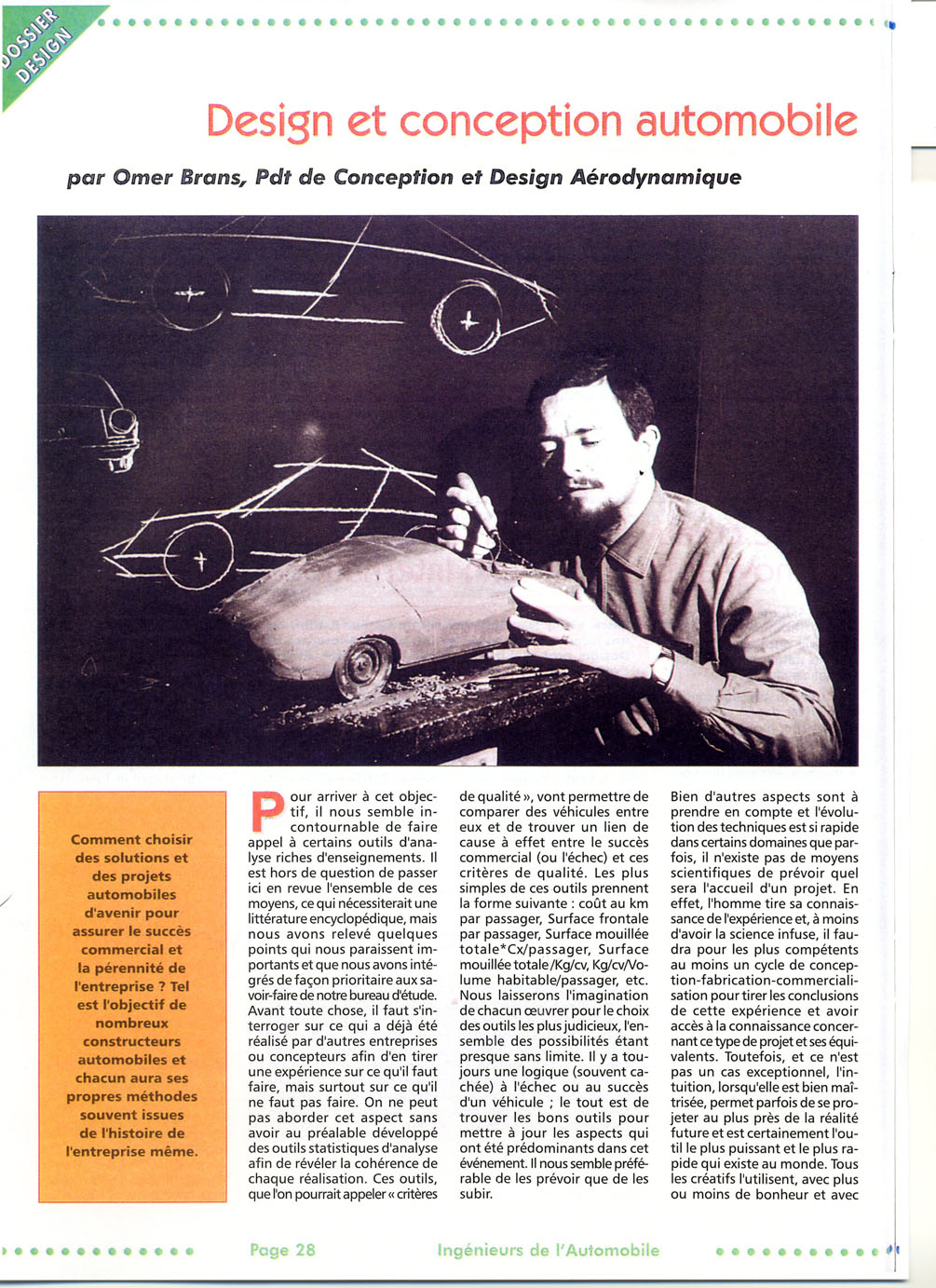
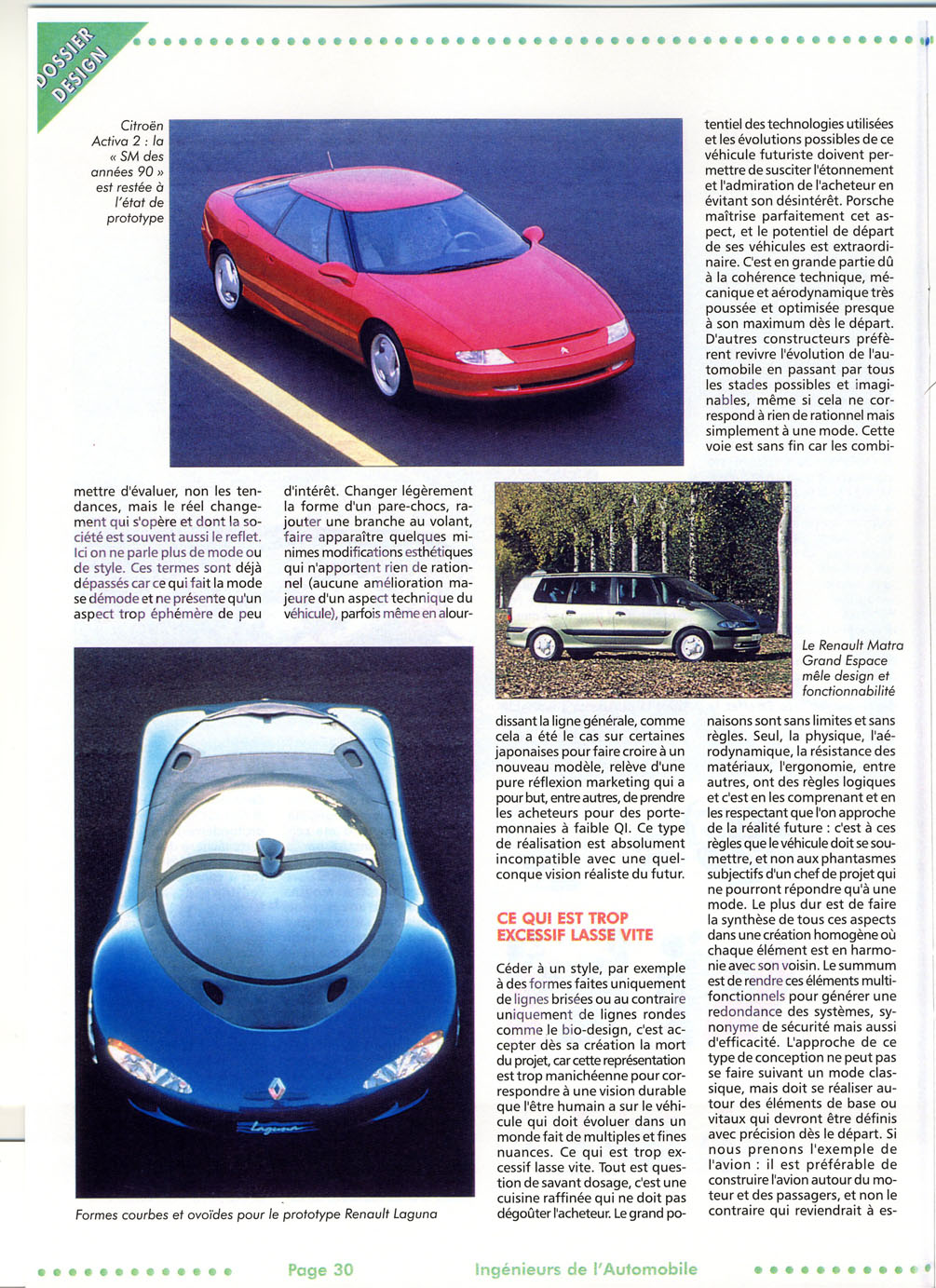
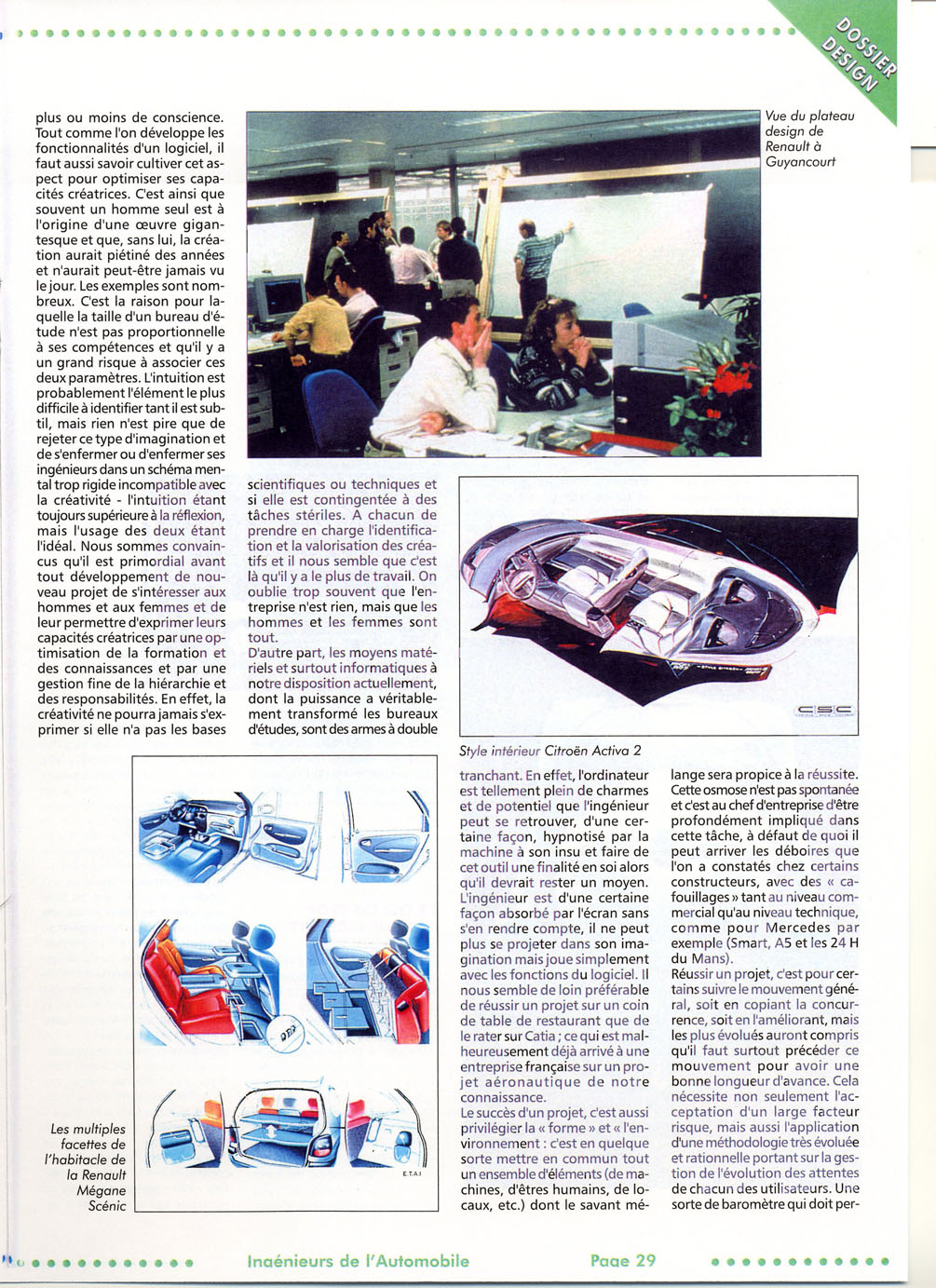
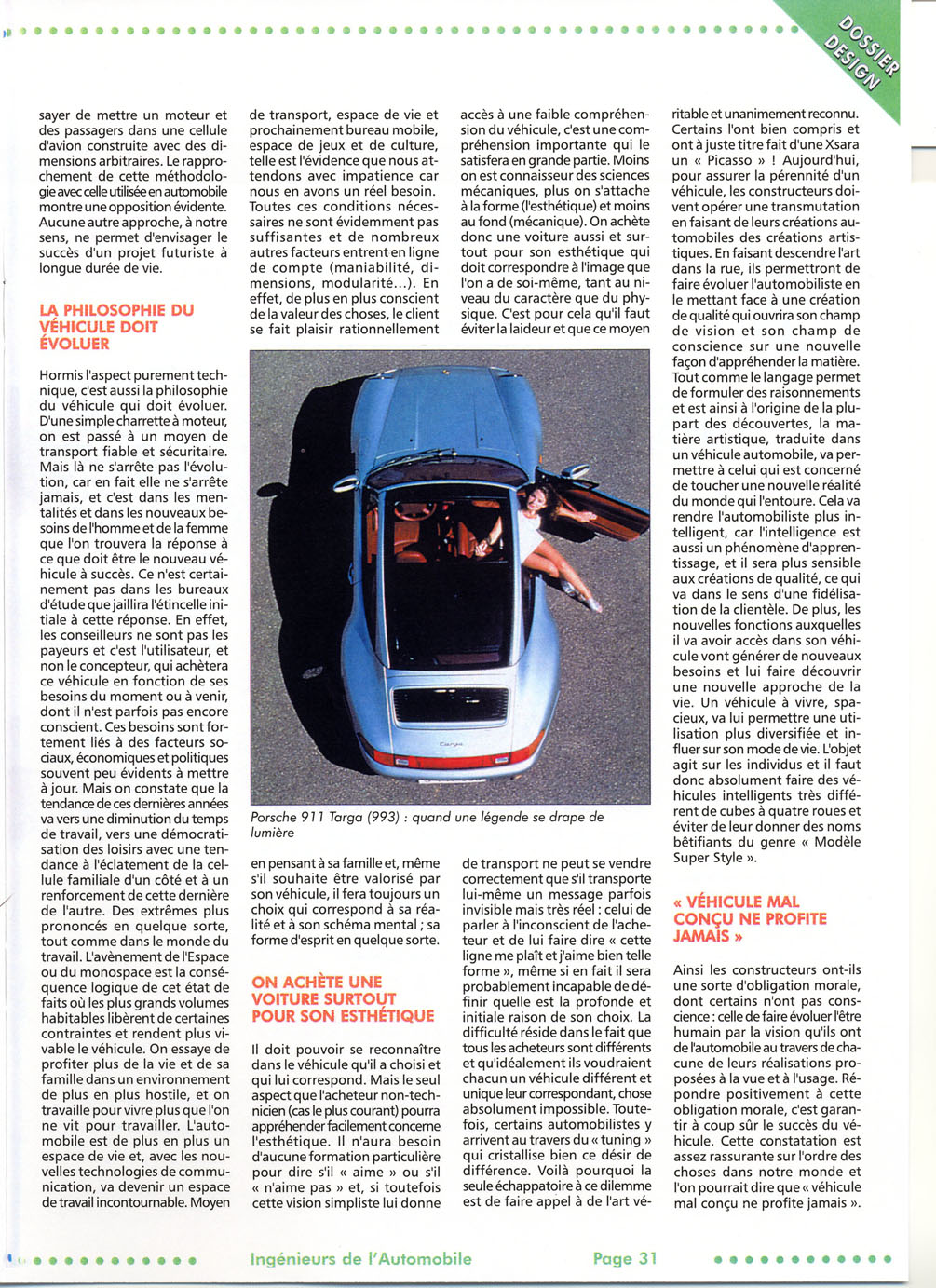
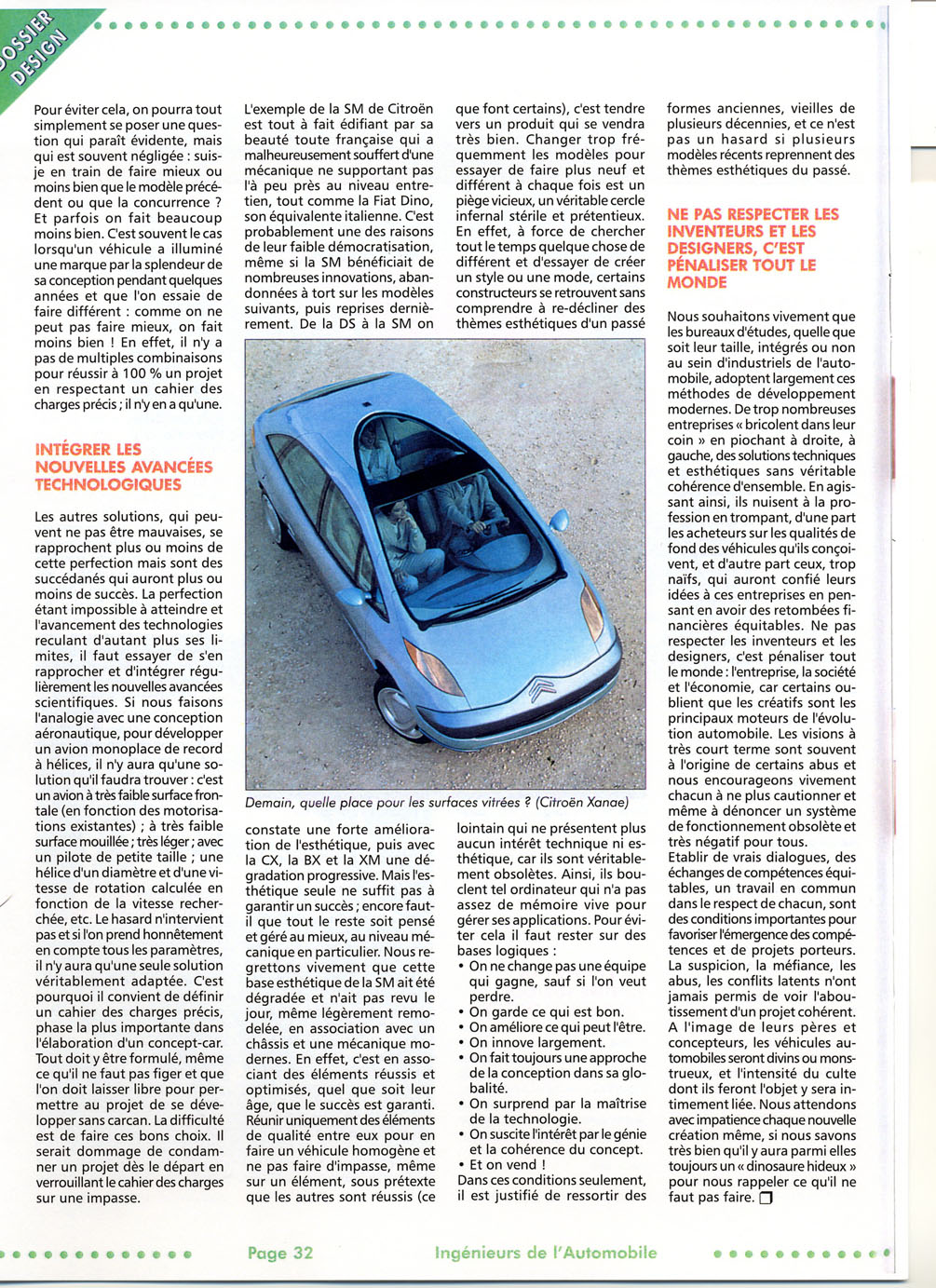
|